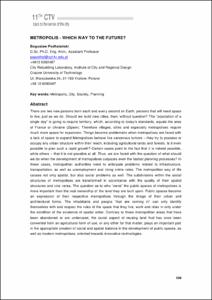Mostra el registre d'ítem simple
Metropolis: which way to the future?
| dc.contributor.author | Podhalański, Bogusław |
| dc.date.accessioned | 2016-10-05T14:31:39Z |
| dc.date.available | 2016-10-05T14:31:39Z |
| dc.date.issued | 2016-07 |
| dc.identifier.citation | Podhalański, Bogusław. Metropolis: which way to the future?. A: Virtual City and Territory. "Back to the Sense of the City: International Monograph Book". Barcelona: Centre de Política de Sòl i Valoracions, 2016, p. 598-606. |
| dc.identifier.isbn | 978-84-8157-660-3 |
| dc.identifier.uri | http://hdl.handle.net/2117/90556 |
| dc.description.abstract | There are two new persons born each and every second on Earth, persons that will need space to live, just as we do. Should we build new cities, then, without question? The “population of a single day” is going to require territory, which, according to today’s standards, equals the area of France or Ukraine (Zipser). Therefore villages, cities and especially metropolises require much more space for expansion. Things become problematic when metropolises are faced with a lack of space to expand Metropolises behave like cancerous tumors – they try to possess or occupy any urban structure within their reach, including agricultural lands and forests. Is it even possible to plan such a rapid growth? Certain cases point to the fact that it is indeed possible, while others – that it is not possible at all. Thus, we are faced with the question of what should we do when the development of metropolises outpaces even the fastest planning processes? In these cases, metropolitan authorities need to anticipate problems related to infrastructure, transportation, as well as unemployment and rising crime rates. The metropolitan way of life causes not only spatial, but also social problems as well. The subdivisions within the social structures of metropolises are transformed in accordance with the quality of their spatial structures and vice versa. The question as to who “owns” the public spaces of metropolises is more important than the real ownership of the land they are built upon. Public spaces become an expression of their respective metropolises through the image of their urban and architectural forms. The inhabitants and people “that are coming in” can only identify themselves with and respect the rules of the space that they live, work and relax in only under the condition of the existence of spatial order. Contrary to those metropolitan areas that have been abandoned or are underused, the social aspect of reusing land that has once been converted from an agricultural form of use, or any other for that matter, plays an important part in the appropriate creation of social and spatial balance in the development of public spaces, as well as modern metropolises, oriented towards innovative technologies. |
| dc.format.extent | 9 p. |
| dc.language.iso | eng |
| dc.publisher | Centre de Política de Sòl i Valoracions |
| dc.relation.ispartof | International Conference Virtual City and Territory (11è: 2016: Cracòvia) |
| dc.rights | Attribution-NonCommercial-NoDerivs 3.0 Spain |
| dc.rights.uri | http://creativecommons.org/licenses/by-nc-nd/3.0/es/ |
| dc.subject | Àrees temàtiques de la UPC::Urbanisme::Aspectes socials |
| dc.subject.lcsh | Sociology, Urban |
| dc.subject.lcsh | Metropolitan areas |
| dc.subject.lcsh | Historic districs |
| dc.subject.other | Metropolis |
| dc.subject.other | City |
| dc.subject.other | Society |
| dc.subject.other | Planning |
| dc.title | Metropolis: which way to the future? |
| dc.type | Conference report |
| dc.subject.lemac | Sociologia urbana |
| dc.subject.lemac | Àrees metropolitanes |
| dc.subject.lemac | Centres històrics |
| dc.identifier.doi | 10.5821/ctv.8078 |
| dc.rights.access | Open Access |
| local.citation.contributor | Virtual City and Territory |
| local.citation.pubplace | Barcelona |
| local.citation.publicationName | Back to the Sense of the City: International Monograph Book |
| local.citation.startingPage | 598 |
| local.citation.endingPage | 606 |
Fitxers d'aquest items
Aquest ítem apareix a les col·leccions següents
-
11th Congress Virtual City and Territory, Krakow, 6-8 July 2016 [121]
Back to the sense of the city


